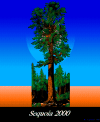 Big Sur
Big Sur
 Big Sur
Big Sur

This is an active document for those reading it with a web browser, such as netscape or mosaic. Clicking on an underlined word will take you into the Glossary, References, or into another document. For anyone reading a hardcopy printout, the URL for on-line access is

Big Sur is a database framework that supports investigations leveraging Sequoia 2000 technology. This introductory section describes:
 User Community
User Community
 Big Sur Framework
Big Sur Framework
 Base Schema
Base Schema
 Middleware & Tools
Middleware & Tools
 Data Domains
Data Domains
A partial list of sponsors include
NASA grants
NAG 5-2224,
NAG 5-2223,
NAGW-2602
.
Complete funding citations for each project is available by following
the specific project links.
Graphics icons for this html draft are from Rutgers University.
